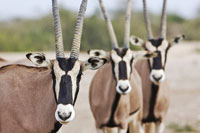
Abu Dhabi has launched a $3 billion eco-tourism project known as Desert Islands, comprised of the former Royal nature reserve of Sir Bani Yas Island, Dalma Island and the Discovery Islands. Together they combine six nature reserves spread across eight islands, all of which will be linked by a ferry and hydrofoil service, water taxis, private resort boat service and regional and sea planes.
When fully operational the project is expected to generate over $325 million in tourism revenue annually. By 2010, when phase one of the project is complete, it is hoped that Desert Islands will attract around 250,000 visitors, rising to over a million a year by 2017.
The Desert Islands have been designed as a sanctuary of nature unique to the Arabian Gulf. It is hoped that they will significantly raise Abu Dhabi's international tourism standing by creating a singular destination with experiences rivalling those of the Caribbean and the Maldives.
Over the years, with the full support of the late Sheikh Zayed, the preservation of natural landscapes, pristine waters, and existing habitats, created a unique environment on Sir Bani Yas and its accompanying islands that host an impressive range of land, marine, and avian wildlife. With warm, shallow waters, newly planted mangroves and restored habitats, the islands have become important feeding and breeding grounds for many species of birds, sea turtles, and other marine life.
The 87 square kilometre Sir Bani Yas Island, which is roughly the size of Guernsey or Ascension Island, and which lies eight kilometres off the mainland, is the heart of the destination. It is home to 68 species of birdlife, and along its shore are sandbanks, inlets and mangrove-fringed inter-tidal lagoons frequented by flamingos, sea gulls and cormorants. It also has two freshwater 'bird lakes' where wild fowl gather. Other birdlife which can be spotted on the island include pintails, shovelers, blackwinged stilts, teals, crab plovers, avocets and grey herons.
More than three quarters of the entire island, which will be home to free roaming animals, will be taken up with resorts, eco-lodges and campsites. At its centre, visitors will be able to take lessons in falconry in a spectacular setting with views over the entire island. Tours of the National Park will be by jeep, cycle and hiking tracks and hot air balloons.
The smaller 33 square kilometre Dalma Island will provide a true heritage experience steeped in history and full of archaeological finds, a place where traditional fishing, farming and aquaculture livelihoods continue.
Centrally located in the centre of the new town is the Dalma Archaeological Museum, home to hundreds of artifacts. Expansion and upgrading of the museum and transformation of in-situ archaeological sites into an interactive learning experience will, it is planned, draw parents to bring their children to learn the value of heritage. The centre will also provide the local people of Dalma with access to vocational education aimed at advancing career opportunities which will emerge from the destination’s tourism expansion. Such courses would focus on generic skill sets, such as English language competency.
Meanwhile, the Discovery Islands and their surrounding seas, which are rich in marine life, are aimed at being a world class example of environmental conservation and ecological tourism.
Two islands, which will be protected areas reserved for existing breeding grounds for birds and turtles, will remain undisturbed to ensure the continuation of a thriving marine population. Two more islands will be devoted to exclusive resorts offering the highest level of service and accommodation. Visitors will arrive by privately-operated ferries and seaplanes. Yet another two islands will provide a ‘wild camp’ experience delivering the authenticity of untouched, isolated, distant and deserted islands.
Visitors to the Desert Islands experience will end their 250 km journey along the coastline from Abu Dhabi when they start off at the 'Marsa Jabel Dhana' gate, which will include a 150-room beachfront hotel, and which will be the destination's arrivals, departure and logistics hub. Arriving primarily by car or tour bus visitors will be able to walk along a pleasant waterfront where they find places to shop, dine, and relax, while waiting to catch the next ferry to the islands.
And central to the Desert Islands strategy will be the importance of maintaining eco-systems covering power, water, infrastructure, waste management and recycling to energy building standards, and tourism-related elements. It will utilise solar and wind solutions throughout. Eventually the emirate is likely to be the 'greenest area' in the region, as renewable energy from the 850KW Sir Bani Yas wind turbine, the largest of its kind in the region, is supplying electricity to a national electricity network in the region for the first time.
